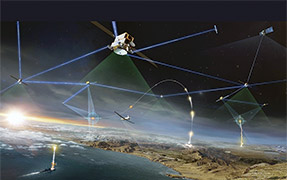Frozen water drops in the nanoworld
Ultrashort-laser processing is usually regarded as a nonthermal technique in which thermal damage (such as cracking and decomposition) is avoided. However, we have found that thermal processes—melting, flow, bending, and inflation—become prominent under specific conditions. Characteristic nanostructures are generated as a result (see Figure 1).1–5 Liquids in the form of normal water drops are frozen in time on a CCD by a flash of light. Nanoliquids freeze as the temperature decreases because of thermal conduction and radiation.
The shape of normal water drops is controlled by varying the physical properties of the liquid and the kinetic properties of the drop. These correspond to target and laser parameters, respectively. Upon irradiation of a 10nm-thick gold thin film on sapphire (0001) crystalline substrate by a single shot of a four-beam interfering femtosecond (fs) laser (pulse width 130fs, central wavelength 790nm), we generated a nanowaterdrop:1 see Figures 1(a) and 1(b). The period of the interference pattern was 1.3μm, and energy was pumped periodically based on this pattern. As a result, a process similar to normal water-drop formation occurs in the nanoarea. The thin film melts, creating a nanowaterdrop structure that is frozen as the temperature drops and can be observed using scanning-electron microscopy. The structure's height was approximately 800nm, while the bead and neck radii were 75 and 18nm, respectively.

For a 20nm-thick film, the process changes from liquid to inflated, and a nanobump structure is generated:2 see Figure 1(c). The underlying mechanism is similar to preparing a ‘Mochi’ grilled rice cake, which inflates and rises because of vapor pressure. As shown in Figure 1(d), for a 5nm-thick film, we generated a nanomesh through laser ablation.3 The process thus varies among ablative, liquid, and inflated, depending on film thickness. It also varies as a function of pulse width, interference pattern, and target material. For example, using a wider-period interference pattern (3.9μm) and silicon (100) crystal substrate—which has a higher thermal conductivity and is opaque to the laser's wavelength—we generated a nanowater crown:4 see Figure 2(a). Ablated holes appear in the matrix, and nanosized ridges form at the edge of each hole. Some have sharp structures, and the curvature radius is approximately 7nm: see Figure 2(b). In addition, some—like the array shown in Figure 2(c)—have a liquid-like structure similar to those in Figure 1(a). On the other hand, for a period of 1.7μm, a nanowhisker forms on the bump—see Figure 2(d)—with a sharp top and a curvature radius <15nm. The spiky structures in Figures 1 and 2 generate field enhancements and are quite useful in nanotechnology.

The size of these structures ranges from several to hundreds of nanometers, implying that these are mesoscopic nanomaterials. They vary in size and structure and are useful in optical, plasmonic, and terahertz devices, metamaterials, and as growth base for bottom-up nanomaterials. The key advantage of using interference is the automatic, precise, and variable array period. A stand-alone structure might be generated by a single beam. However, it is bothersome to focus nanoscale lasers, and laser fluctuations must be considered. From a practical point of view, a wide area, uniform period, and adaptability to different materials are important, while processing time should also be considered. In addition, we generated all structures without any evacuation or special gas, implying that the atmospheric cost is free.
In summary, we have developed a new surface-modification technique using top-down nanotechnology. The process changes with target structure and laser parameters. However, because more parameters (such as pulse number, atmospheric conditions, and target structure) could affect the efficiency of the process, more combinations should be investigated to generate interesting structures. Hence, we are trying to find new structures that will widen the scope of the nanotechnology world.
The scanning-electron-microscope observation was performed using a Hitachi S-5200 at Osaka University's Research Center for Ultra-High Voltage Electron Microscopy. This work is partly financially supported by the Amada Foundation For Metal Work Technology, the Japanese Science and Technology agency, and the Japan Society for the Promotion of Science.
Yoshiki Nakata has been involved in laser processing and spectroscopy for nearly 20 years, with a focus on applications of laser-induced plasma, 2D imaging spectroscopy, and development of high-power lasers. He started fs laser processing in 1998 and has been awarded eight prizes by a number of academic societies and foundations.
Takuya Hiromoto is a Master's student. His work relates to fs laser processing.
Noriaki Miyanaga is a professor. He has been involved in developing high-power lasers and laser fusion for more than 25 years.



